Arts & Culture
A Guide to Exploring The Brilliance of Bucks County
Just two-and-a-half hours northeast of Baltimore, Pennsylvania’s “Genius Belt”—a nickname dubbed by author James Michener—still casts its creative spell.
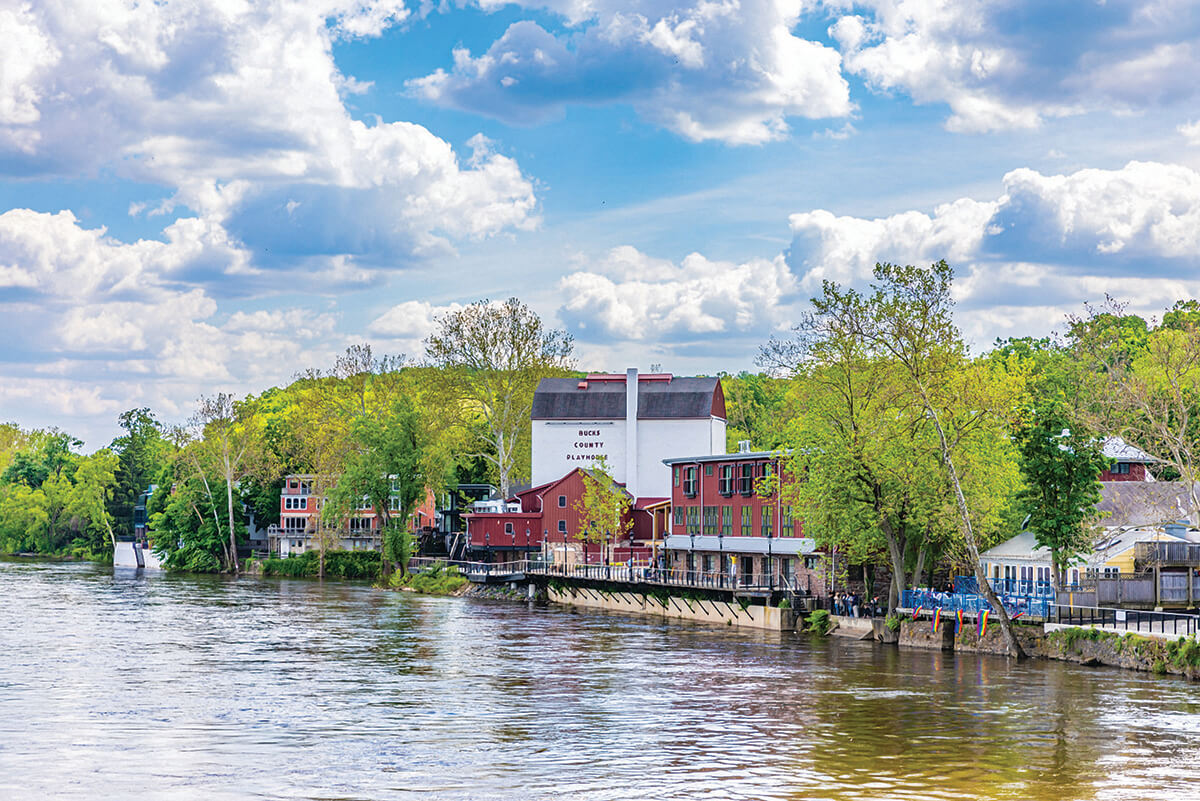
Follow the leafy, graveled path that hugs the Delaware Canal through New Hope, Pennsylvania, and you’ll pass two touchstones of local talent. One sits north of town. In this humble, 18th-century gristmill-turned-studio, Pennsylvania Impressionism was born over a century ago. In town, the burgundy-and-white, barn-like theater that opened 85 years ago on another mill site was launched by some of Broadway’s and Hollywood’s brightest stars.
The Phillips’ Mill arts center and Bucks County Playhouse—both still thriving—make touristy New Hope the cradle of visual and performing arts in Bucks County. But the village is not the only cultural outpost in this pastoral Philadelphia exurb.
One of Pennsylvania’s three original Quaker-settled counties, Bucks lies 25 miles north of Philadelphia, 75 miles southwest of New York City, and 130 miles (two and a half hours) northeast of Baltimore.
Blessed with natural resources and resourceful residents, the county has been famously productive since William Penn claimed the place in 1682. Grain, milk, and cheese. Cigars and applejack brandy. Wool, textiles, and lumber. Cannonballs for George Washington’s troops. An iconic line of Bucks-grown seeds for gardeners (Burpee!). Not to mention a slew of Academy Awards, Tony Awards, Grammys, Pulitzer Prizes, and a Nobel Prize from the people who have called it home.
Scenery, serenity, and urban accessibility beckoned the creatively inclined at the turn of the 20th century. First came plein-air painters—landscape artists like Edward Redfield, who rendered the wooded hillsides, weathered stone houses, and winding waterways in all seasons, lights, and climatic conditions.
Soon after, seclusion-seeking writers arrived—playwrights, lyricists, and novelists who penned works bound for Broadway, Hollywood, and best-seller lists. (Think Moss Hart, Oscar Hammerstein II, and Pearl S. Buck.) They made permanent or second homes in what one of them, author James Michener, dubbed “the genius belt.”
Although growth has crept into the county since, Bucks retains its rural charm and creative lineage for visitors’ enjoyment. New Hope may be the nexus of Bucks culture, but Doylestown, the county seat, also packs cultural cred. And it’s arguably the best place to begin your Bucks visit.
Dabble in Doylestown
The James A. Michener Art Museum (yes, that Michener, behind the iconic Bay-themed novel Chesapeake) boasts a permanent collection of more than 2,700 objects with galleries devoted to American art and studio craftsmanship, as well as two sculpture gardens. Special permanent exhibits honor two legendary locals: Michener, the prolific author, Doylestown native, and later-in-life philanthropist and California emigre George Nakashima, the master woodworker whose studio still operates in the county.
The museum has transformed Bucks’ abandoned 19th-century county prison into an elegant residence for the arts. An entire gallery devoted to American Impressionism houses one of the finest collections of Pennsylvania Impressionistic paintings, including works by William Lathrop, Edward Redfield, Daniel Garber, Charles Rosen, Rae Sloan Bredin, Robert Spencer, Fern Coppedge, and John Fulton Folinsbee.
Beginning with Lathrop and Redfield, these artists fashioned abandoned mills, aging farmhouses, and crumbling mansions into affordable homes and studios beside the Delaware River in and around New Hope.
“It was a very beautiful place to be, along the river with beautiful, rolling hills,” says Michener chief curator Laura Turner Igoe of the area’s artistic appeal.
Many members of the New Hope art colony trained at the Pennsylvania Academy of Fine Arts in Philadelphia when Impressionism was in vogue, she says. At the turn of the century, an old saying goes, there were two kinds of academy students, “one kind went to Paris, and the other went up the Delaware.”
Art lovers can view works by the Pennsylvania Impressionists, the New Hope modernist painters who succeeded them, and contemporary painters, sculptors, and craftspeople at the Michener. Don’t miss “A Wooded Watershed,” a stunning, fan-shaped mural painted by Daniel Garber for the Sesquicentennial Exposition of 1926 in Philadelphia, or the boldly portrayed landscapes of Redfield, who defied the elements to spend an entire day—often past dark—to make one painting. Snow scenes were favorite subjects for Bucks Impressionists, no matter the obstacles to creating them.
“They’d strap their canvases to the trees so they could paint in the snowstorm,” says Igoe.
Other highlights at the Michener include the meditative Nakashima Reading Room, a traditional Japanese-style space designed by George Nakashima’s daughter, who runs her late father’s New Hope studio. The museum’s striking Powell Door is an intricately carved, arched portal inspired by craftsman Phillip Lloyd Powell’s travels in Morocco.
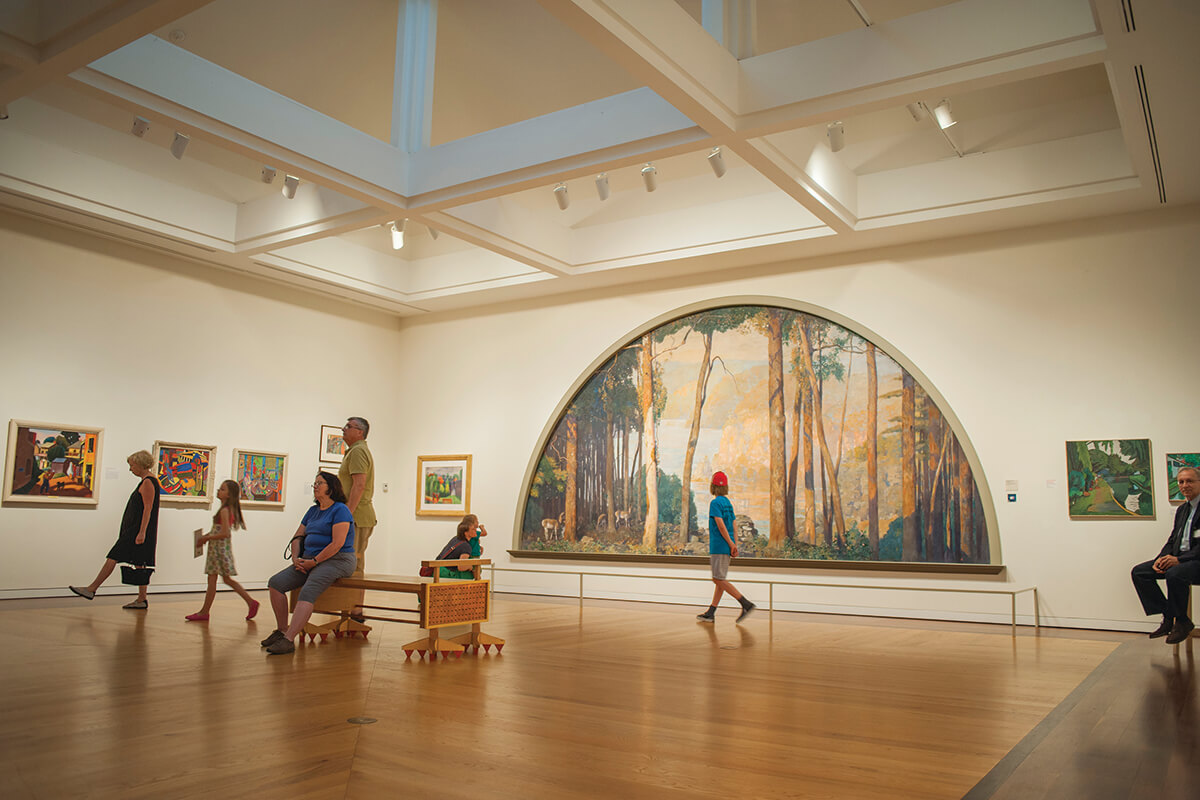
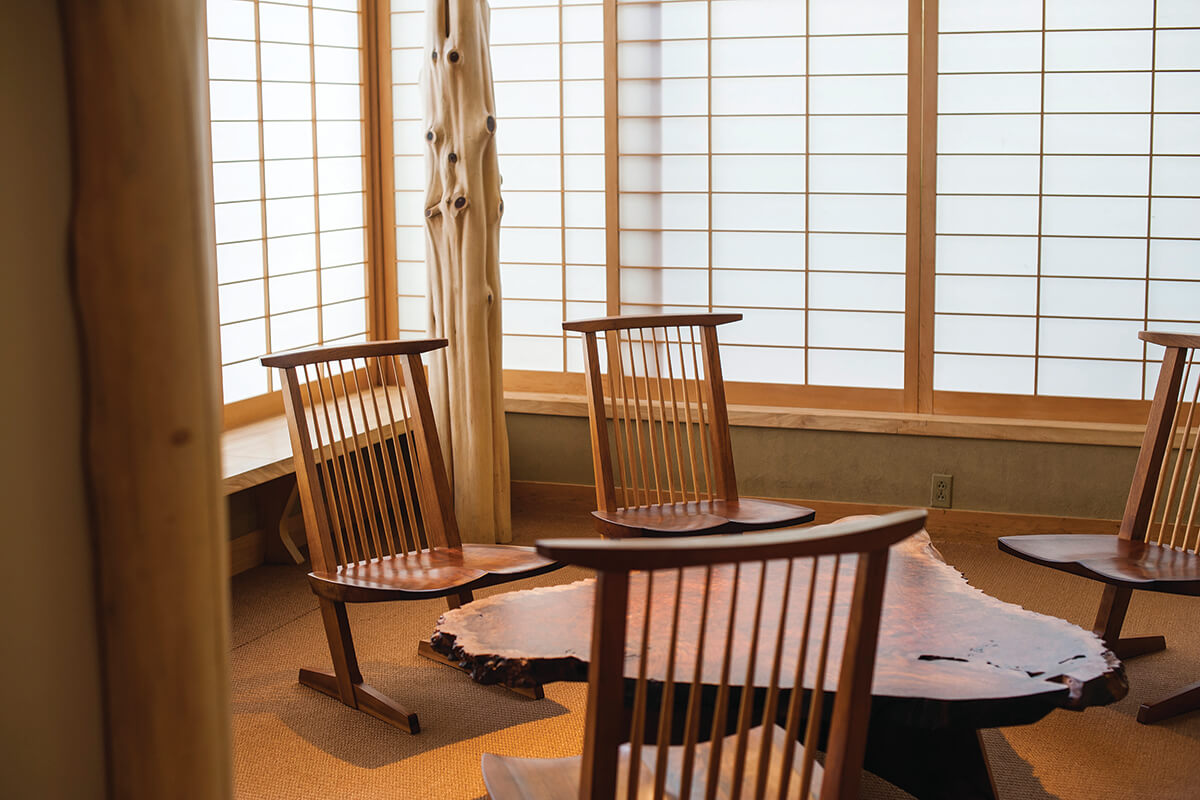
Leave ample time to browse the extensive exhibit devoted to the museum’s namesake. Admire Michener’s library, browse his collections of music and artworks, and see the home office where he wrote Tales of the South Pacific. This room is faithfully replicated, down to the typewriter and souvenirs on his desk (including autographed Baltimore Orioles memorabilia).
Opposite the Michener Museum on Pine Street, you’ll find the Mercer Mile, a trio of historic buildings designed in the early 20th century by Henry Chapman Mercer, a leading figure of the Arts and Crafts Movement. An archaeologist by training, a ceramicist by trade, and an antiquarian pack rat by nature, Mercer built his house, his tile-making shop, and a showplace for his voluminous collections in his hometown between 1908 and 1916.
There’s a whiff of the fairy tale about Fonthill, Mercer’s 44-room concrete mansion with its staggered roofs, multiple chimneys, and more than 200 windows.
“An eclectic mix of Gothic, Medieval, and Byzantine architectural styles,” explains the Bucks County Historical Society website, which operates Fonthill and its companion castle, the Mercer Museum.
The latter, an equally fanciful concrete structure, housed Mercer’s treasures when his inventory outgrew Fonthill. Today, it displays tens of thousands of mostly pre-industrial artifacts. Visitors can explore what amounts to a seven-floor attic full of Americana: from bathtubs, boats, and stoves to sleighs and tools used by blacksmiths, cheesemakers, cobblers, potters, weavers, and numerous other crafts- and tradespeople.
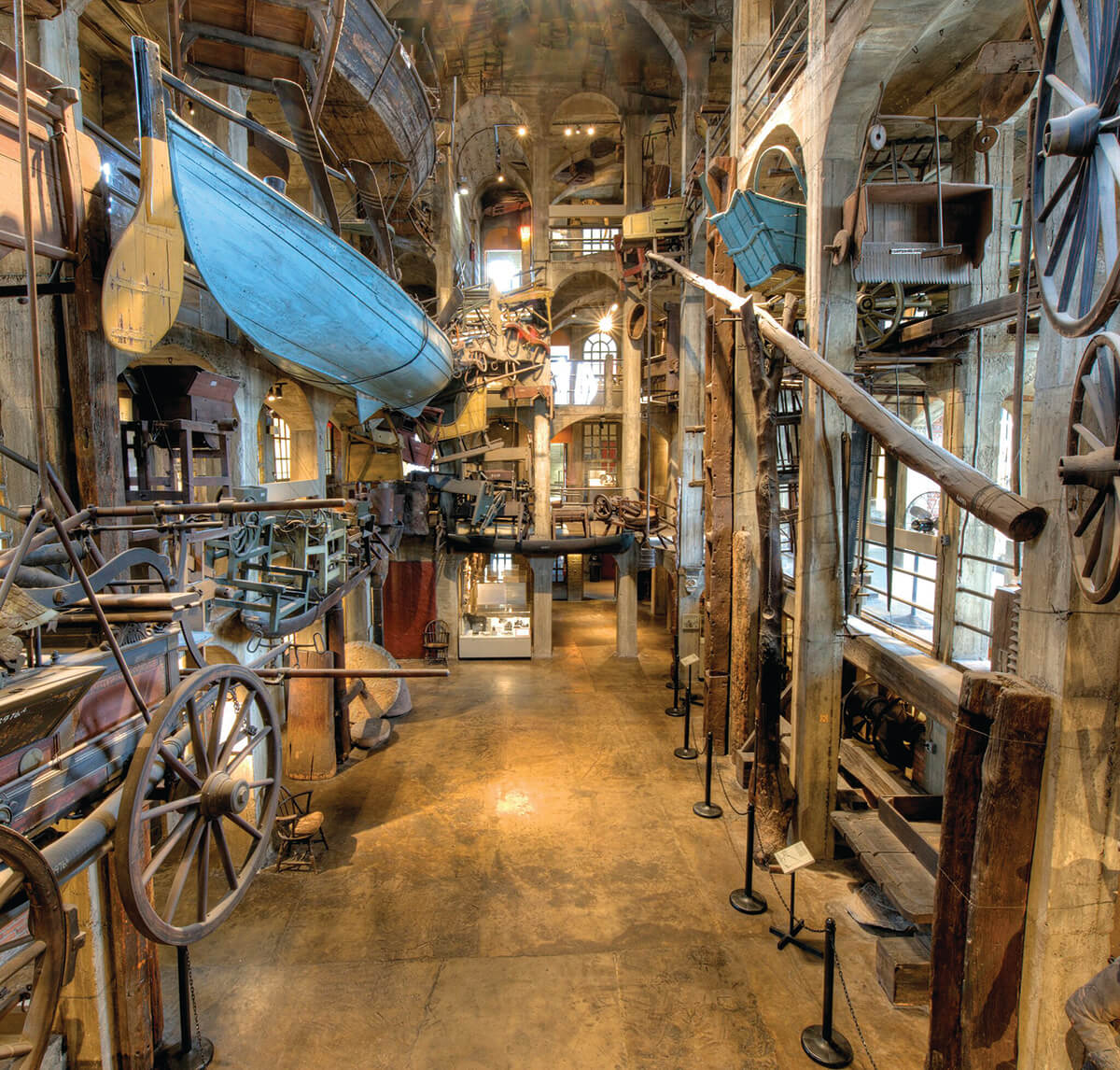
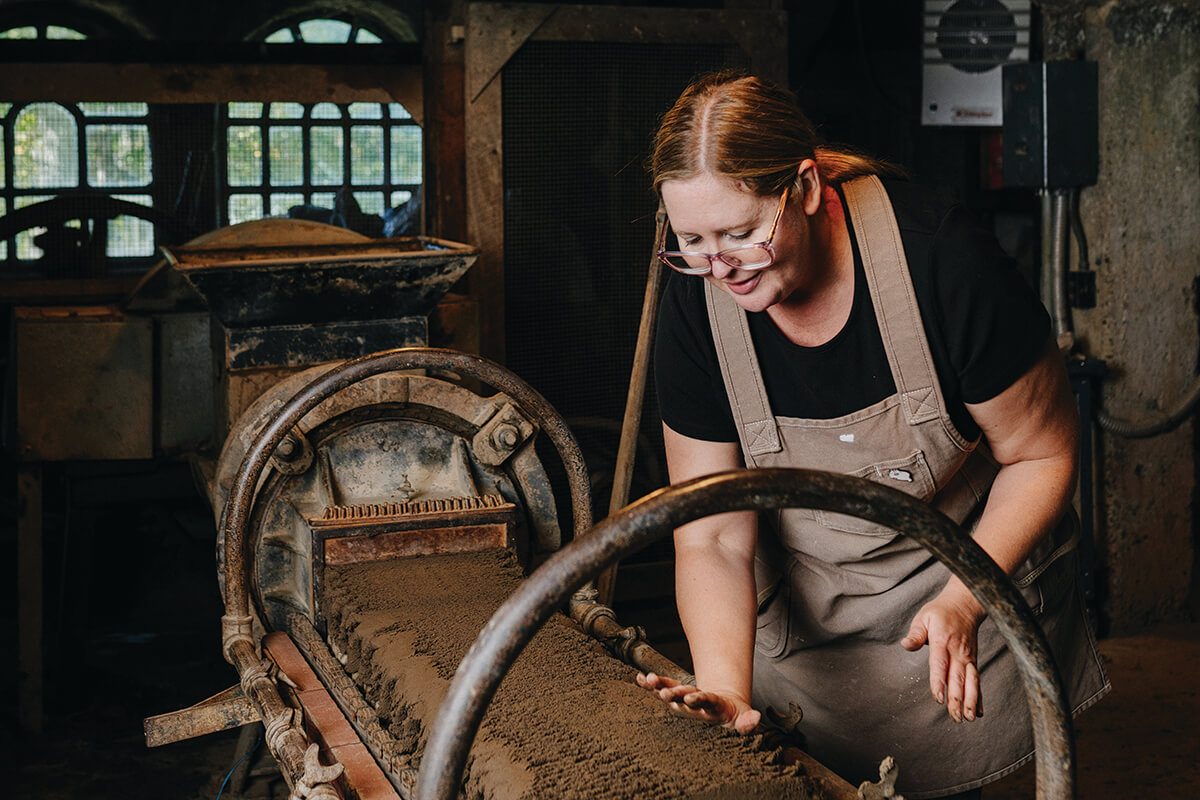
The museum is open six days a week for self-guided, timed-entry tours. Fonthill, which is also the showcase for tiles made by Mercer’s own renowned Moravian pottery, offers one-hour guided tours six days a week, as well as 45-minute evening tours periodically throughout the year. Online reservations are recommended for both.
The Moravian Pottery and Tile Works factory is the third concrete monument to Mercer’s ingenuity. At this working history museum, open daily, tiles are still made the Mercer way: using Bucks County lake clay, authentic glazes, and traditional designs that have adorned everything from the state capitol in Harrisburg to the Monte Carlo Casino in Monaco. Modern-day apprentices learn the tile-making trade here, and visitors can, too. On Tuesdays, tours include a hands-on lesson in making your own Moravian tile. Those and other decorative ceramics are also available at the gift shop.
Bonus Bucks: Reserve tickets to Cocktails at the Castle, the Mercer Museum’s annual fundraising soiree of food, spirits, and music, held in October on the museum grounds.
Enter the Epicenter, New Hope
New Hope was a center of commerce before it became a center of creativity. Goods traveled the Delaware River and adjacent canal. Grist and lumber mills sprang up where streams tumbled into the river. But when waterpower eventually lost its utility in the late 19th century, artists utilized the aging infrastructure.
Considered the dean of the New Hope art colony, William Lathrop made the disused Phillips’ Mill his home and studio in 1899. Fellow artists soon flocked to the area. In 1929, they formed an association to preserve the 1754 mill complex for art exhibitions and social events like popular Sunday teas hosted by the Lathrops.
“It was really the hub of the artistic world in Bucks County,” says the James A. Michener Museum’s Igoe.
And it remains so. The Phillips’ Mill Community Association will host its 95th annual Juried Art Show at the mill this September—the highlight of a calendar that includes a juried photography exhibition each spring, competitions for young artists and emerging playwrights, and cabaret-style musical performances throughout the year.
The arts venue on River Road is part of the Phillips’ Mill Historic District. Just across the way, you’ll spy more evidence of New Hope’s creative legacy. Behind ivy-draped stone walls and ornate iron gates sits the Gothic-style English Village—a group of eight historic buildings that were the working domain of Morgan Colt, an architect, painter, and craftsman who settled there in 1905. A nonprofit is currently working to preserve and restore the sylvan compound, hoping to lure working artists once more.
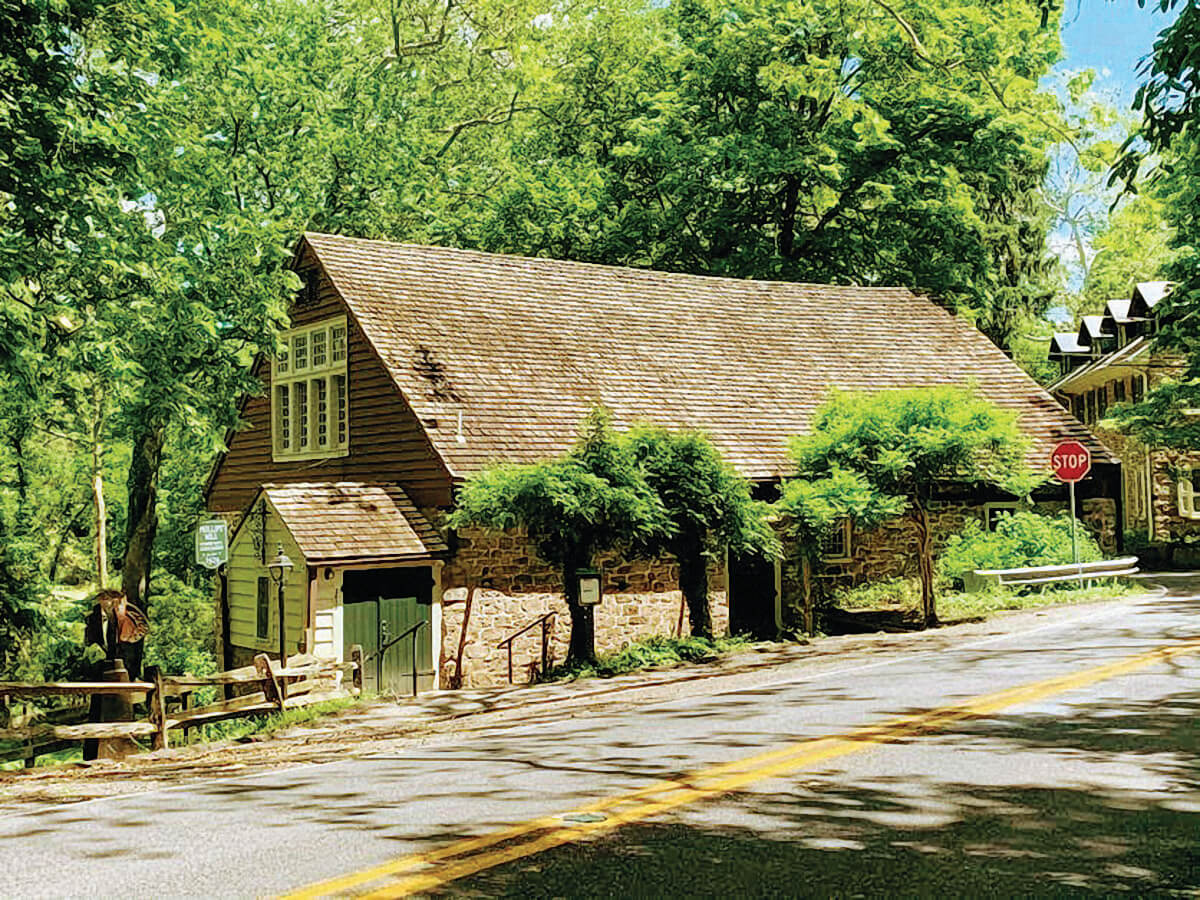
Explore New Hope and its opposite-shore neighbor, Lambertville, New Jersey, and you’ll discover a thriving arts community filled with dozens of galleries and studios. Two miles south of town, George Nakashima Woodworkers carries on the tradition of George Nakashima, who found work in Bucks County after securing his release from a Japanese-American internment camp in 1943. The family-run studio hosts tours on Friday afternoons and Saturdays from April through October. Advance registration is required through the Nakashima Foundation for Peace.
New Hope also became a social center for VIPs of both the stage and the printed page when the Bucks County Playhouse opened in 1939. Celebrated playwright and local resident Moss Hart helped rally the community—including some famous friends—to convert an abandoned mill into a summer theater.
“With the blessing of Broadway celebrities and $40,000 of their funds, work was started today on the Bucks County playhouse,” reported The York Dispatch in March 1939.
Artist Charles Child (later known as the brother-in-law of Julia Child) painted the original—and still used—stage curtain, featuring a birds-eye view of New Hope. On July 1, 1939, the playhouse opened with Springtime for Henry, starring character actor Edward Everett Horton.
In the decades since, acting royalty have trod Playhouse boards: Helen Hayes, Lillian Gish, Hart’s writing collaborator (and neighbor) George S. Kaufman, Hume Cronyn and Jessica Tandy, Leslie Nielsen, Bea Arthur, Walter Matthau, Bob Fosse, Robert Redford, Bernadette Peters, Mike Nichols, and Liza Minnelli, among others. Grace Kelly and Dick Van Dyke made their stage debuts here in 1949 and 1959, respectively. Also here in 1952, Angela Lansbury walked onto an American stage for the first time. And Harpo Marx spoke (!) during a guest appearance here in the Hart-Kaufman hit, The Man Who Came to Dinner.
The playwrights were as famous as the players. Thornton Wilder appeared in his own work, Our Town, here in 1948, and Neil Simon’s first play had its world premiere at the Playhouse in 1960.
Today, the Bucks County Playhouse stages its own productions and hosts performances by visiting musicians, magicians, comedians, and other acts during a season that runs from April through December. This season’s house productions include the musicals Grease and The Rocky Horror Picture Show.
When the Playhouse opened, sponsors vowed to find and nurture unrecognized talent. “We hope to root out talent wherever it is,” said actor Richard Bennett (father of Hollywood’s Constance, Barbara, and Joan) at the 1939 groundbreaking. That effort continues. The Student Theater Festival, in its 56th year, is a multi-week event in which student actors perform on the venue’s historic stage, attend workshops, and learn from theater professionals.
Bonus Bucks: Sip a gin tipple and dine on snacks, sandwiches, or entrees at the theater’s modern Playhouse Deck restaurant, perched above the lovely Delaware River. Proceeds support the nonprofit Playhouse and its theatrical mission.
Barnstorm Bucks
Craving the country life, celebrated New Yorkers snapped up Bucks County farms in the 1930s and ’40s. Literary wit Dorothy Parker had a farm near Pipersville. Her Algonquin Round Table mate George S. Kaufman bought one just minutes away in Holicong. Humorist S. J. Perelman raised turkeys at Eight Ball Farm in Erwinna. Actor Claude Rains had pigs and cattle at his place in Lambertville. Moss Hart married actress Kitty Carlisle in New Hope in 1946, and they lived the rural life nearby in Aquetong.
A handful of farms of the famous are open to the public. Kaufman’s 100-acre Barley Sheaf Farm is a luxurious bed-and-breakfast near the popular attraction Peddler’s Village. Suites in the 1740 fieldstone manor house, a stone-bank barn, and several 1930s-era guest cottages are named for the playwright’s works. Pulitzer Prize- and Nobel Prize-winning novelist Pearl S. Buck lived at Green Hills Farm in Perkasie until her death in 1973, decorating its 19th-century farmhouse with artifacts from her beloved Asia.
Designated a National Historic Landmark and run by the humanitarian foundation that bears her name, the Pearl S. Buck House is open for guided house tours (see the typewriter on which she wrote The Good Earth). Visitors can also stroll beautiful gardens on the 67-acre estate, Buck’s burial place.
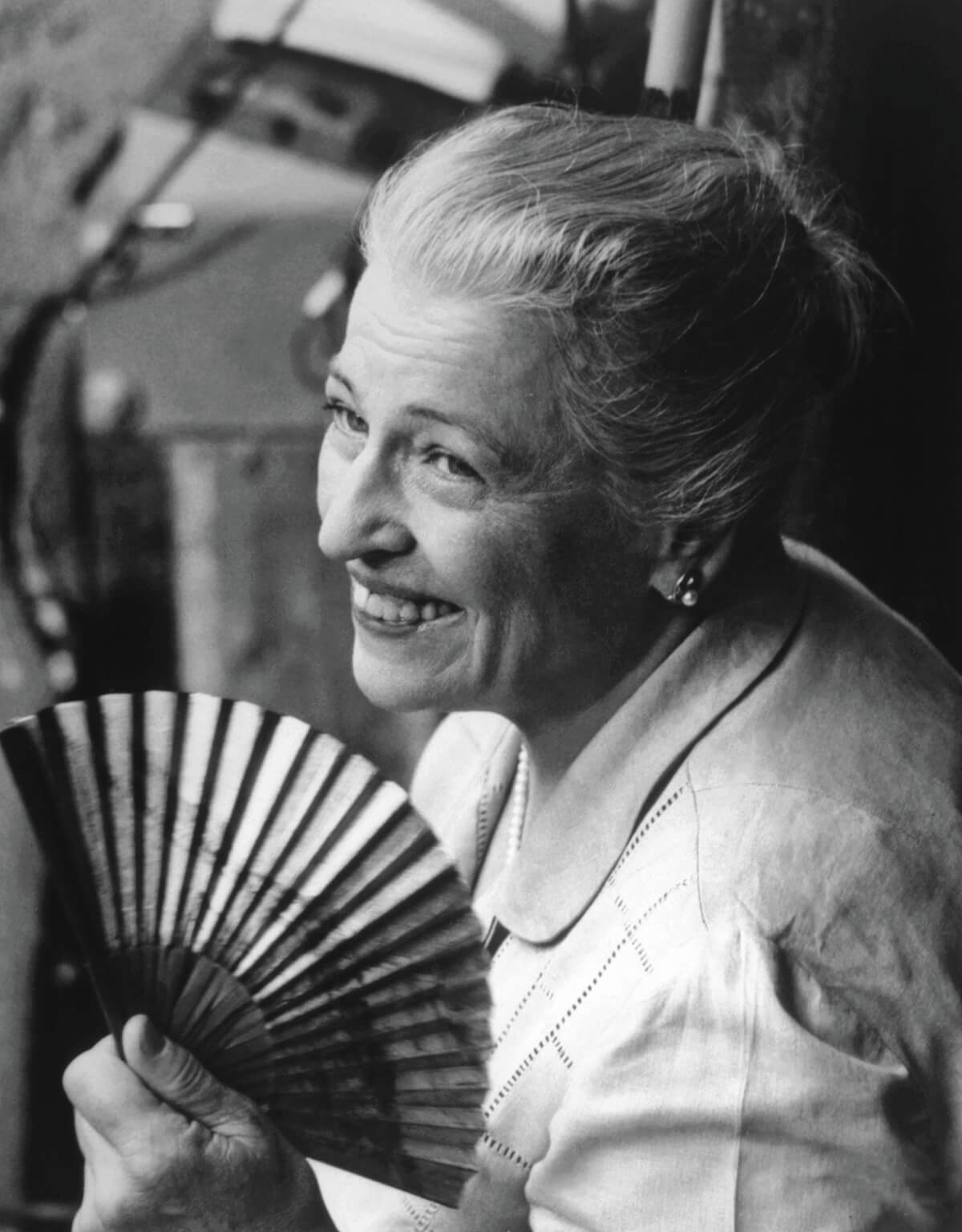
About 10 miles away in Doylestown, Highland Farm was the home of Oscar Hammerstein II and birthplace of the lyricist’s famous collaborations with composer Richard Rodgers. Scores for The King and I, Oklahoma, Carousel, South Pacific, and The Sound of Music were written in the 1840 farmhouse, which overlooked fields where “corn is as high as an elephant’s eye” (in the famous words of “Oh, What a Beautiful Morning”). Here, too, Hammerstein mentored a young Stephen Sondheim.
Once a B&B itself, Highland Farm is now owned by the nonprofit Oscar Hammerstein Museum, which hopes to restore it as a museum and theater education center in the future. It’s reported that more than 75 Academy Awards, Grammy Awards, Tony Awards, and Pulitzer Prizes can be directly traced to Highland Farm.
Bonus Bucks: Reserve the Inn at Barley Sheaf Farm’s Art Deco “You Can’t Take It with You” suite and channel the creative vibes in George S. Kaufman’s former writing room.